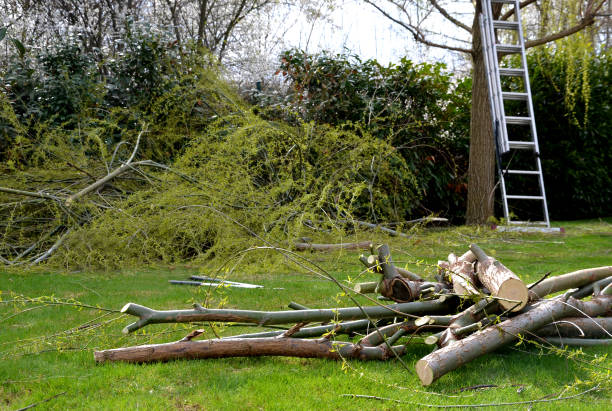Comprehensive Guide to Tree Lot Clearing

Tree lot clearing is a crucial process in land management and development. It involves the removal of trees, stumps, and other vegetation from a specific area to prepare the land for construction, landscaping, or other uses. This task requires careful planning and execution to ensure environmental responsibility, safety, and efficiency. Understanding the nuances of tree lot clearing helps in achieving optimal results while minimizing impact on the surrounding ecosystem.
Why Tree Lot Clearing is Essential
Tree lot clearing in Salt Lake City UT serves various purposes depending on the project’s goals. Here’s why it’s a fundamental step in land preparation.
Preparing Land for Development
Clearing a tree lot is often the first step in preparing land for new construction projects, such as residential, commercial, or industrial developments. Removing trees and vegetation provides a clean slate for building foundations, roadways, and other infrastructure.
Enhancing Aesthetic Appeal
For landscaping projects, tree lot clearing can significantly enhance the visual appeal of the area. It allows for the design and implementation of new landscapes, gardens, or recreational spaces that align with the project’s vision.
Improving Land Health
Clearing underbrush and invasive species can improve the overall health of the land. It reduces competition for resources among plants, allowing native vegetation to thrive and promoting biodiversity.
Methods of Tree Lot Clearing
Various methods are employed for tree lot clearing, each suited to different types of terrain and project requirements.
Mechanical Clearing
Mechanical clearing involves using heavy machinery such as bulldozers, excavators, and skid steer loaders to remove trees and vegetation. This method is efficient for large areas and allows for the simultaneous removal of stumps and debris.
Manual Clearing
Manual clearing is a labor-intensive method that uses hand tools such as chainsaws, axes, and loppers. This approach is often used for smaller areas or where access is limited. It allows for more precise control and reduces the risk of damage to the surrounding environment.
Chemical Clearing
Chemical clearing involves using herbicides to kill trees and vegetation before removal. This method is effective for managing invasive species and preparing the land for further treatment. However, it requires careful application to avoid harming desirable plants and wildlife.
Controlled Burning
Controlled burning, or prescribed burning, involves intentionally setting fires under controlled conditions to clear vegetation. This technique can be used to manage fire hazards, improve soil health, and promote the growth of certain plant species. It requires careful planning and monitoring to ensure safety and effectiveness.
Environmental Considerations in Tree Lot Clearing
Tree lot clearing must be conducted with environmental considerations in mind to minimize adverse impacts.
Wildlife Protection
Clearing areas can disrupt local wildlife habitats. It is important to assess and address the presence of wildlife before beginning the clearing process. Measures such as timing the clearing to avoid nesting seasons and providing alternative habitats can help protect wildlife.
Soil Erosion Control
Removing trees and vegetation can lead to soil erosion, especially on slopes or in areas with loose soil. Implementing erosion control measures such as silt fences, erosion control blankets, and replanting can help prevent soil loss and protect water quality.
Reforestation and Replanting
After clearing a lot, reforestation or replanting can help restore the environment. Planting native trees and vegetation helps to offset the impact of clearing and supports the recovery of local ecosystems.
Best Practices for Tree Lot Clearing
Adhering to best practices ensures efficient and responsible tree lot clearing.
Planning and Assessment
Before starting the clearing process, conduct a thorough assessment of the site. This includes evaluating the type of vegetation, the presence of wildlife, and any potential environmental impacts. Proper planning helps to select the most appropriate clearing method and minimizes risks.
Compliance with Regulations
Ensure that tree lot clearing complies with local, state, and federal regulations. This may include obtaining permits, following guidelines for environmental protection, and adhering to safety standards.
Safety Measures
Implement safety measures to protect workers and the surrounding environment. This includes using personal protective equipment, maintaining machinery, and setting up safety zones around the clearing area.
Professional Expertise
For large or complex clearing projects, consider hiring professionals with expertise in tree lot clearing. Experienced contractors have the knowledge and equipment to perform the task efficiently and safely.
Frequently Asked Questions (FAQs)
What is tree lot clearing?
Tree lot clearing is the process of removing trees, stumps, and other vegetation from a designated area to prepare the land for construction, landscaping, or other uses. It involves various methods and requires careful planning to ensure environmental responsibility and safety.
Why is tree lot clearing necessary?
Tree lot clearing is necessary to prepare land for development or landscaping projects, enhance aesthetic appeal, improve land health, and manage vegetation effectively. It provides a clean and usable area for new projects and promotes the overall health of the land.
What are the common methods used for tree lot clearing?
Common methods for tree lot clearing include mechanical clearing, manual clearing, chemical clearing, and controlled burning. Each method is suited to different types of terrain and project requirements and has its own set of benefits and considerations.
How does tree lot clearing impact the environment?
Tree lot clearing can impact the environment by disrupting wildlife habitats, causing soil erosion, and affecting local ecosystems. To mitigate these effects, it is important to implement measures such as wildlife protection, soil erosion control, and reforestation.
What are the best practices for tree lot clearing?
Best practices for tree lot clearing include thorough planning and assessment, compliance with regulations, implementing safety measures, and hiring professional expertise when needed. These practices ensure that the clearing process is efficient, responsible, and effective.
Conclusion
Tree lot clearing is a critical step in land management and development that requires careful consideration of various factors. By understanding the methods, best practices, and environmental impacts associated with tree lot clearing, you can ensure a successful and responsible clearing process. Whether preparing land for new construction or enhancing a landscape, following these guidelines will help achieve optimal results while minimizing negative effects on the environment.



